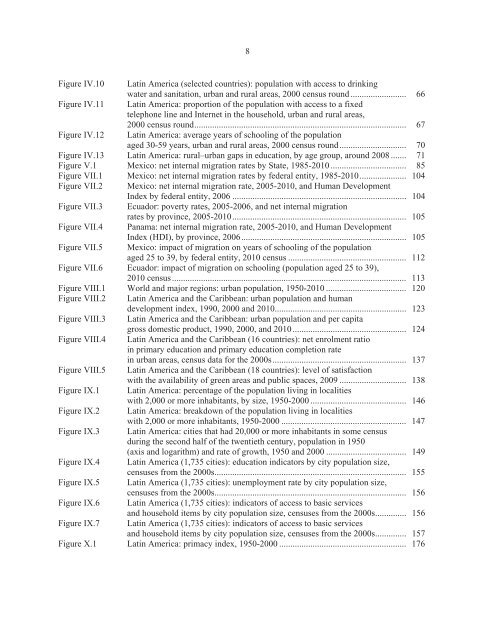Population, territory and sustainable development
The purpose of this document is to provide an overview of current trends, contexts and issues in the spheres of population, territory and sustainable development and examine their public policy implications. Three themes run through the report. The first two are laid out in the empirical chapters (III through X); the third is taken up in the closing chapter. Using the most recent data available (including censuses conducted in the 2010s), the first theme describes and tracks location and spatial mobility patterns for the population of Latin America, focusing on certain kinds of territory. The second explores the linkages between these patterns and sustainable development in different kinds of territory in Latin America and the Caribbean. The third offers considerations and policy proposals for fostering a consistent, synergistic relationship between population location and spatial mobility, on the one hand, and sustainable development, on the other, in the kinds of territory studied.
The purpose of this document is to provide an overview of current trends, contexts and issues in the spheres of population, territory and sustainable development and examine their public policy implications. Three themes run through the report. The first two are laid out in the empirical chapters (III through X); the third is taken up in the closing chapter. Using the most recent data available (including censuses conducted in the 2010s), the first theme describes and tracks location and spatial mobility patterns for the population of Latin America, focusing on certain kinds of territory. The second explores the linkages between these patterns and sustainable development in different kinds of territory in Latin America and the Caribbean. The third offers considerations and policy proposals for fostering a consistent, synergistic relationship between population location and spatial mobility, on the one hand, and sustainable development, on the other, in the kinds of territory studied.
You also want an ePaper? Increase the reach of your titles
YUMPU automatically turns print PDFs into web optimized ePapers that Google loves.
8<br />
Figure IV.10 Latin America (selected countries): population with access to drinking<br />
water <strong>and</strong> sanitation, urban <strong>and</strong> rural areas, 2000 census round ......................... 66<br />
Figure IV.11 Latin America: proportion of the population with access to a fixed<br />
telephone line <strong>and</strong> Internet in the household, urban <strong>and</strong> rural areas,<br />
2000 census round ............................................................................................... 67<br />
Figure IV.12 Latin America: average years of schooling of the population<br />
aged 30-59 years, urban <strong>and</strong> rural areas, 2000 census round .............................. 70<br />
Figure IV.13 Latin America: rural–urban gaps in education, by age group, around 2008 ....... 71<br />
Figure V.1 Mexico: net internal migration rates by State, 1985-2010 .................................. 85<br />
Figure VII.1 Mexico: net internal migration rates by federal entity, 1985-2010 ..................... 104<br />
Figure VII.2 Mexico: net internal migration rate, 2005-2010, <strong>and</strong> Human Development<br />
Index by federal entity, 2006 .............................................................................. 104<br />
Figure VII.3 Ecuador: poverty rates, 2005-2006, <strong>and</strong> net internal migration<br />
rates by province, 2005-2010 .............................................................................. 105<br />
Figure VII.4 Panama: net internal migration rate, 2005-2010, <strong>and</strong> Human Development<br />
Figure VII.5<br />
Index (HDI), by province, 2006 .......................................................................... 105<br />
Mexico: impact of migration on years of schooling of the population<br />
aged 25 to 39, by federal entity, 2010 census ..................................................... 112<br />
Figure VII.6 Ecuador: impact of migration on schooling (population aged 25 to 39),<br />
2010 census ......................................................................................................... 113<br />
Figure VIII.1 World <strong>and</strong> major regions: urban population, 1950-2010 .................................... 120<br />
Figure VIII.2<br />
Figure VIII.3<br />
Figure VIII.4<br />
Figure VIII.5<br />
Figure IX.1<br />
Figure IX.2<br />
Figure IX.3<br />
Latin America <strong>and</strong> the Caribbean: urban population <strong>and</strong> human<br />
<strong>development</strong> index, 1990, 2000 <strong>and</strong> 2010........................................................... 123<br />
Latin America <strong>and</strong> the Caribbean: urban population <strong>and</strong> per capita<br />
gross domestic product, 1990, 2000, <strong>and</strong> 2010 ................................................... 124<br />
Latin America <strong>and</strong> the Caribbean (16 countries): net enrolment ratio<br />
in primary education <strong>and</strong> primary education completion rate<br />
in urban areas, census data for the 2000s ............................................................ 137<br />
Latin America <strong>and</strong> the Caribbean (18 countries): level of satisfaction<br />
with the availability of green areas <strong>and</strong> public spaces, 2009 .............................. 138<br />
Latin America: percentage of the population living in localities<br />
with 2,000 or more inhabitants, by size, 1950-2000 ........................................... 146<br />
Latin America: breakdown of the population living in localities<br />
with 2,000 or more inhabitants, 1950-2000 ........................................................ 147<br />
Latin America: cities that had 20,000 or more inhabitants in some census<br />
during the second half of the twentieth century, population in 1950<br />
(axis <strong>and</strong> logarithm) <strong>and</strong> rate of growth, 1950 <strong>and</strong> 2000 .................................... 149<br />
Figure IX.4 Latin America (1,735 cities): education indicators by city population size,<br />
censuses from the 2000s ...................................................................................... 155<br />
Figure IX.5 Latin America (1,735 cities): unemployment rate by city population size,<br />
censuses from the 2000s ...................................................................................... 156<br />
Figure IX.6 Latin America (1,735 cities): indicators of access to basic services<br />
<strong>and</strong> household items by city population size, censuses from the 2000s .............. 156<br />
Figure IX.7 Latin America (1,735 cities): indicators of access to basic services<br />
<strong>and</strong> household items by city population size, censuses from the 2000s .............. 157<br />
Figure X.1 Latin America: primacy index, 1950-2000 ......................................................... 176


















